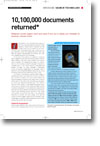
Access all areas
- Article 5 of 26
- M-iD, February 2004
Web sites that do not take into account the needs of users with disabilities are not only discriminatory - they may also be illegal.
Page 1 | Page 2 | Page 3 | All 3 Pages
For web users with disabilities - for whom online access to services might improve their quality of life considerably - the web is impenetrable territory. In fact, surveys conducted by web usability specialist Nielsen Norman Group indicate that, for disabled users, many web sites are up to three times harder to use.
The operators of these sites, when shown the problems that they pose for disabled users, argue that, while it would be preferable to make them more accessible, it is either too difficult or expensive to do so - or simply not a priority.
Those organisations may be surprised to hear that their web sites may be breaking the law, laying them open to bad publicity or even prosecution and fines. Yet with a little thought and advice, they could remove those barriers and end up with extremely loyal users, a web site accessible by a far greater range of devices than just PCs, and reduced maintenance costs for their sites.
Alternative choice
Often, the problems that a web user with disabilities faces stem from the construction of the page rather than its content. A user with sight problems, for example, can access a web site with a screen reader, a program that reads out the text on the screen while providing some idea of how it has been formatted. Braille screens are also available. However, users will have no idea what information a picture is trying to convey unless some kind of description of it is provided.
Hypertext markup language (HTML) provides web designers with this facility: every image can have 'ALT(ernative)' text that screen readers will read out. However, even though virtually every web design tool in the world supports ALT text - and the latest versions of HTML mandate its use for all images - many web designers do not provide ALT text for pictures.
The result is that an important home page graphic that conveys the organisation's beliefs, explains the navigation options of the site, and lists the services it provides and where they can be found, is presented as just one word: Image.
Users with sight problems are not the only group that finds certain web sites hard to use. Five per cent of men are colour blind and may find it hard to understand information when colour is the only differentiator, for example. Long or complex text can present challenges for deaf users whose first language is signing, people with learning difficulties, and those with dyslexia. Elderly web surfers may have problems manipulating a mouse with sufficient dexterity and reading smaller text. People with physical handicaps and spatial awareness problems can use a range of different tools in place of a mouse and keyboard to control a computer but may find it hard to navigate through many links or select them, particularly if the links are close together. Epileptics may have severe reactions to pages that have blinking graphics or text.
Leaving aside the legal implications of a web site that cannot be used by such users (see box, Legal requirements), there are major benefits to making web sites accessible.
“The best reason to make a web site accessible is to acquire a group of very loyal customers,” says Jakob Nielsen, principal at web sign consultancy the Nielsen Norman Group. “Users with disabilities generally get quite poorly treated on the web. If your web site doesn't treat them badly, that's the one they'll use. And people communicate: if a company discriminates against someone, 10 other people will hear about it; if it doesn't, 10 other people will hear about that too.”
Jason Taylor of Usablenet, a company specialising in making web sites accessible to the disabled, agrees. “Disabled users will stay very loyal to a site that is accessible, if only because they've gone through the pain of trying to find a site that works, something that can take a long time,” he says.
Page 1 | Page 2 | Page 3 | All 3 Pages

